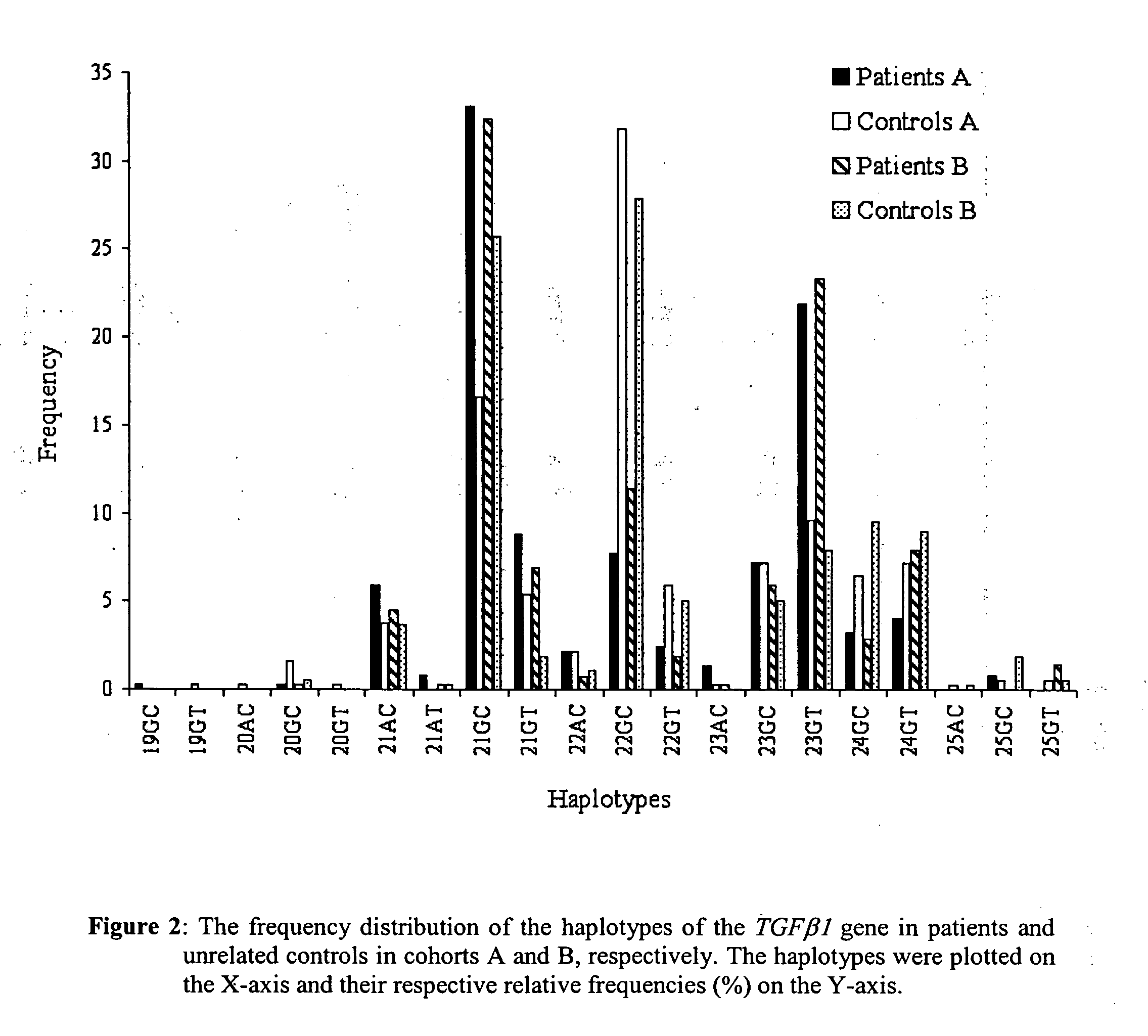Transforming growth factor beta 1 (TGFbeta1) haplotypes and prediction of susceptibility for immunological disorders
a technology of transforming growth factor and haplotype, which is applied in the field of haplotypes of human transforming growth factor beta1 and prediction of susceptibility for immunological disorders, can solve the problems of abnormal transcriptional regulation, significant increase in risk, and defective protein expression, so as to reduce airway hyper reactivity, predict susceptibility, and suppress inflammation
- Summary
- Abstract
- Description
- Claims
- Application Information
AI Technical Summary
Benefits of technology
Problems solved by technology
Method used
Image
Examples
example 1
Patient and Healthy Volunteers
[0131] Unrelated patients were recruited from various hospitals in Northern India in cohort A (N=187) and Western India in cohort B (N=209), respectively (Table 6). Ethical approval was obtained from the review board of each hospital. Written informed consent was obtained from all individuals participating in the study. Asthma, in the recruited study population was defined by clinical history and validated later by interview questions (details of environmental factors, family history of asthma / atopy, the geographical region of origin and migration status). Patients (mean age 28.42±0.97 and 34.22 yrs±1.01 yrs for cohort A and B, respectively) were diagnosed for asthma on the basis of National Asthma Education and Prevention Program (Expert Panel Report-2) guidelines (National Asthma Education and Prevention Program, J Allergy Clin Immunol 110:S141-S219, 2002) and were examined for a self-reported history of breathlessness and wheezing. The clinical para...
example 2
[0134] To demonstrate the association of the CT / CA repeat locus with atopic disorders such as asthma, Kolmogorov-Smirnov test was performed (Nagarkatti et al., 2000; Carriere and Kochar 2000, Mukawa et. al., 1989). The Kolmogorov-Smimov Test is a non-parametric test, which gives the likelihood of two ordered categorizations coming from different orderings or the same ordering. The Kolmogrov-Smirnov test (KS-test) tries to determine if two datasets differ significantly. The KS-test has the advantage of being more powerful than the chi-square test in many situations. This analysis showed significant differences between the allele count distribution of patient and control groups [probability value (p)=10−6]. We observed a significantly different pattern of distribution of the alleles between the two groups; alleles 21 and 23 were over-represented in the patient group whereas alleles 22 and 24 were the major alleles in the control group (FIG. 3). When the cases and controls were compare...
example3
[0136] To demonstrate the association of −800 G / A polymorphism, χ2 test was performed. Of the three genotypes, AA, GA, GG; AA was the rare genotype with only one individual in the control group having AA at −800 locus (FIG. 4). Excluding AA genotype from the analysis, a significant difference in the distribution of the genotypes was observed between the patient and the control groups (χ2=4.89, df=1, p=0.026).
PUM
| Property | Measurement | Unit |
|---|---|---|
| Fraction | aaaaa | aaaaa |
| Fraction | aaaaa | aaaaa |
| Fraction | aaaaa | aaaaa |
Abstract
Description
Claims
Application Information
 Login to View More
Login to View More - R&D
- Intellectual Property
- Life Sciences
- Materials
- Tech Scout
- Unparalleled Data Quality
- Higher Quality Content
- 60% Fewer Hallucinations
Browse by: Latest US Patents, China's latest patents, Technical Efficacy Thesaurus, Application Domain, Technology Topic, Popular Technical Reports.
© 2025 PatSnap. All rights reserved.Legal|Privacy policy|Modern Slavery Act Transparency Statement|Sitemap|About US| Contact US: help@patsnap.com


